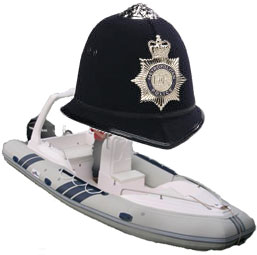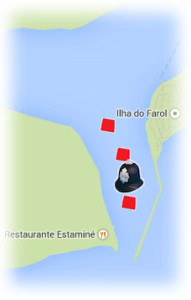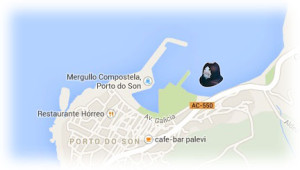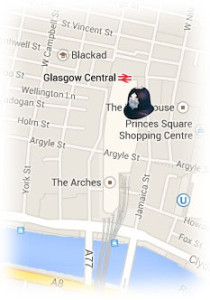Two rozzers in a RIB provide my second experience of being boarded at sea by the maritime police.
It did nothing to cure my cynicism.
Nor my paranoia.
 Returning home from the airport my cabbie shared with me a memory of his first package holiday to Portugal’s Algarve coast. With the Mediterranean firmly in mind he ran joyously down the broad, sandy beach and plunged himself into the inviting blue waters. With the North Atlantic firmly in mind he ran the hell back out again.
Returning home from the airport my cabbie shared with me a memory of his first package holiday to Portugal’s Algarve coast. With the Mediterranean firmly in mind he ran joyously down the broad, sandy beach and plunged himself into the inviting blue waters. With the North Atlantic firmly in mind he ran the hell back out again.
Sailors probably have a better grasp of geography than the average package holidayer; even the worst of us tend at least to know what bit of water we’re looking at. Occasionally though we can still be seduced by a little regional guilt-by-association. The Algarve isn’t the Mediterranean but it is just round the corner from it. The Mediterranean is non-tidal and the Algarve’s Atlantic coastline is, but as they’re so very close one could perhaps be forgiven for thinking not by much.
And one would be wrong.
For sure the tidal ranges might not be in the 10 metre (33 foot) plus ballpark some of us have to contend with on our more northerly coastlines but nonetheless the streams and ranges on this coast cannot be ignored, especially when so many ports of call are on shallow, sandy shores where streams can be amplified, seas made choppy and proper pilotage can make the difference between a night snug in a bar or a night stranded on a sandbank.
In terms of tidal streams though it can fair rip through the narrow entry between the breakwaters at Cabo de Santa Maria. 7 knots of tide against you if you get your timing wrong isn’t something you want to try in a 36-foot sailboat.
Planning an overnight stop at the quiet little anchorage at Olhão we timed our entrance at slack water and started to motor through the breakwaters with perhaps half an hour of daylight left. With visibility good we were expecting no surprises other than perhaps the odd bit of fisherman’s impedimenta to avoid.
But we did get a little surprise when we started picking out the line of three port hand buoys marking the leftmost edge of the entry channel.
A fourth object bobbed in the water between the first pair of them.
A small, gray RIB.
Once is happenstance
 I hoisted and lowered the motoring cone more times on this two-week trip than I have over the rest of my sailing life put together. This was not mere anality on the skipper’s part though as the boat-bobbies in these parts do seem to have a bit of a reputation for treating yachties as a cash-machine and being fond of fining them for small breaches of the rules of the road
I hoisted and lowered the motoring cone more times on this two-week trip than I have over the rest of my sailing life put together. This was not mere anality on the skipper’s part though as the boat-bobbies in these parts do seem to have a bit of a reputation for treating yachties as a cash-machine and being fond of fining them for small breaches of the rules of the road
The skipper’s prescience could soon be proven, though it can be hard to work out what a small boat bobbing in the distance is up to. They didn’t appear to be fishing. They didn’t look like divers. Servicing the buoys perhaps?
As we discounted the benign possibilities, rather like someone discovering a lump on their body might distract themselves with the non-fatal diagnoses first, the RIB started to move. With a growing sense of defeat we watched it motor astern of us and then turn to approach our transom.
Yep, it was the Faro fuzz … and they were coming our way.
We were asked for our passports and the ship’s papers. So far, so formal, but then he proceeded to pull out a blank notepad and started to write our details down free-form. The slightly casual feel of this was strengthened when his enthusiasm palpably waned once confronted with the assortment of middle names one of my crewmates carried. The boat, occasionally used as a reserve by a local sea school, was maintained to UK MCA standards and his enthusiasm waned further still when he spotted the coding certificate in the ship’s papers. Shortly afterwards he made a polite departure, stepping comfortably back from our transom onto his bobbing bow.
No search of the boat, no inspections and no questions other than a passing inquiry as to how the three of us knew each other. Also no explanations and, though conditions were benign and there was no other traffic in the channel, there’s plenty of important safety stuff to focus on when entering a harbour and it would be nice to think the risk and inconvenience was for a good reason. He could, after all, have followed us until we were safely berthed and checked us over afterwards.
Twice is coincidence
 This isn’t the only time I’ve been boarded by the seaborne Sweeney. The other time was close to the border between Spain and Portugal too, though this time on the Spanish side and in the north. Perhaps there’s some smugglers’ secret to this border I’m unaware of. Or perhaps I just look dodgy.
This isn’t the only time I’ve been boarded by the seaborne Sweeney. The other time was close to the border between Spain and Portugal too, though this time on the Spanish side and in the north. Perhaps there’s some smugglers’ secret to this border I’m unaware of. Or perhaps I just look dodgy.
We’d stopped overnight at the anchorage outside the marina at Porto do Son in the Spanish Rias, the cost-conscious skipper always favouring a free night over a marina berth. As we were drifting into wakefulness the following morning we watched with some idle curiosity a chunky patrol boat hovering in the distance, and with growing unease as it dropped a somewhat knackered tub of a launch into the water and three uniformed men headed in our direction.
Safely at anchor this was not an uncomfortable or inconvenient experience but it was lengthy and made lengthier by the three of them speaking no English and the three of us speaking no Spanish. Their obscure question as to our engine’s serial number took some effort to translate. Our blokeish answers as to each crewmember’s position on the boat were perhaps best left untranslated.
This felt much more like a genuine, matter-of-routine inspection though I’m still nonplussed as to what, well within the waters of the European Union, they might have been looking to find on a thirty-nine foot British flagged sailboat at anchor off a quiet seaside town that would justify the time and effort involved.
Three times, it’s enemy action
 My only other brush with the law in my adult life was also a stop-and-search, though this time squarely on dry land after disembarking a train at Glasgow Central station. A cursory poke in my luggage followed by ten minutes of paperwork. Still, at least the Scots have a sense of humour and we share a language (if not an accent).
My only other brush with the law in my adult life was also a stop-and-search, though this time squarely on dry land after disembarking a train at Glasgow Central station. A cursory poke in my luggage followed by ten minutes of paperwork. Still, at least the Scots have a sense of humour and we share a language (if not an accent).
The cynic in me put that one down to flattering the figures a little at the month-end – “Today lads I want you to nip down to Central and nab the first white guy off of each train.” The search itself seemed to serve little other purpose; I could have had ten pounds of Semtex in a suicide vest in my bag and they wouldn’t have spotted it so I doubt they’d seriously pegged me as the albino wing of Al-Qaeda.
But maybe I’m wrong. Maybe I really do just look dodgy. And maybe I am too; after all I seem to have started quoting Goldfinger.